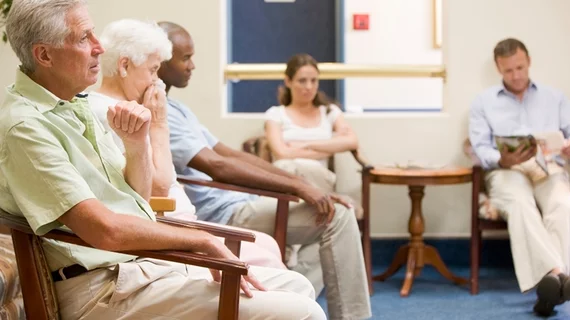Real-time location systems streamline workflow, improve patient satisfaction
Real-time location systems are an effective way to track patient processing and room utilization times noninvasively, as well as offer insight into how radiology practices can run more efficiently, a group of Johns Hopkins researchers report in the current edition of Practical Radiation Oncology.
Patient wait and processing times are two metrics crucial to a clinic’s performance, lead author Kevin Conley, MD, and colleagues wrote, but the lack of a standardized system for reporting those numbers means accuracy can suffer.
“Efforts to address multifaceted concerns about clinic operations depend on the availability of accurate information with regard to the duration of activities related to patient care,” Conley, of the Johns Hopkins School of Medicine Department of Radiation Oncology and Molecular Radiation Sciences in Baltimore, Maryland, wrote. “Historically, this information has been drawn from patient information systems, collected by clinic personnel or reported by paid observers. In our experience, patient information systems provide insufficient data to fully describe the flows of care providers.”
That insufficiency could stem from faulty definitions of wait time and processing time, the authors said. Wait time is typically defined as the time between a patient’s arrival at the clinic and entry into an exam room, while time spent in the room is considered processing time.
“This characterization systematically ignores time spent in the examination room waiting for service,” Conley et al. said. “If these definitions are used, performance will consistently understate total waiting times and overstate processing times.”
In an effort to improve those shortfalls, the researchers implemented a previously dormant real-time location system (RTLS) into their radiation oncology clinic, where data from the system was collected for 84 patients receiving consultations, follow-ups, on-treatment visits and nurse visits. Room entry and exit times were marked by the RTLS, and Conley’s team used unique metrics to describe intervals, like room time, room delay and the ratio of face time to total cycle time, or face-time efficiency.
Face-time efficiency levels for consultations, follow-up appointments, on-treatment visits and nurse visits during the study were 30.1 percent, 22.9 percent, 33 percent and 25.6 percent, respectively, the authors reported. Eliminating physician interruptions and any coordination-related delays would increase those numbers to 41.3 percent, 38.9 percent, 54.7 percent and 38.7 percent.
The average room time at the clinic was 69.1 minutes, Conley and colleagues said, but that was offset by an average room delay of 48.7 minutes. That means that, for 84 patients, clinic staff used more than 5,804 minutes just to process patient information.
“The detailed mapping of provider movement on the basis of data from the RTLS revealed that the average room delay within the examination room of 48.7 minutes exceeded the average 27.1 minute wait experienced in the waiting room,” the authors said, noting these findings could be used to identify gaps in flow and develop more efficient workplace practices. “This finding is critical because room delay relates to both room utilization and patient experience.”
The RTLS approach used by the researchers could be applicable in a number of similar urban academic clinics, they said, because patients, clinicians and administrators alike benefit from a more well-adjusted metrics system. Patients with shorter wait times tend to be happier, clinicians without unnecessary delays are less stressed and managers who don’t have to deal with inefficient labor save money and time.
Successful implementation of such programs has been rare, the authors wrote, likely because people fail to understand the system’s capabilities or technology. Sometimes, though, Conley and co-authors said, they’re just overwhelmed by the sheer amount of data an RTLS can generate.
“A real-time location system can be used to augment a patient management system and automate data collection to provide improved descriptions of clinic performance,” the authors wrote. “We hope that applications of our approach can be used to improve understanding of clinic operations.”

